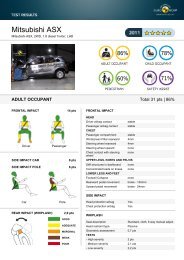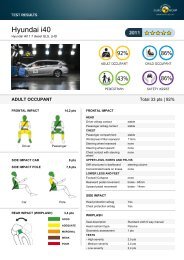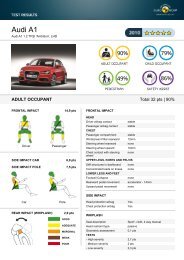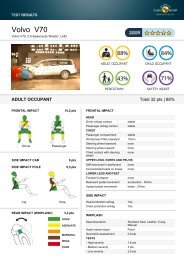Pedestrian Test Protocol - Euro NCAP
Pedestrian Test Protocol - Euro NCAP
Pedestrian Test Protocol - Euro NCAP
You also want an ePaper? Increase the reach of your titles
YUMPU automatically turns print PDFs into web optimized ePapers that Google loves.
Version 7.0<br />
March 2013<br />
M<br />
e<br />
<br />
t<br />
2<br />
t<br />
1<br />
Fdt<br />
v<br />
Me = Effective mass (kg)<br />
F = Force (N)<br />
Δv = Change in Velocity (m/s)<br />
dt = Time increment (s)<br />
t1 = Time of first contact (s)<br />
t2 = Time of peak force (s)<br />
2.2.3.1.11 In the event that a system triggers before the peak force is imparted onto the bumper<br />
cross member, the following calculation should be used:<br />
t<br />
2<br />
<br />
t<br />
M e t<br />
1 <br />
2<br />
<br />
t<br />
1<br />
Fdt<br />
adt<br />
Me = Effective mass (kg)<br />
F = Force (N)<br />
a = Leg acceleration (m/s 2 )<br />
dt = Time increment (s)<br />
t1 = Time of first contact (s)<br />
t2 = Time of system trigger (s)<br />
2.2.3.1.12 For the calculation of effective mass, only movement in the X direction is<br />
considered. The most significant structures that load the leg should be considered,<br />
such as the bumper cross member and any upper or lower cross beams. Less<br />
significant structures, such as grills and valances may be ignored. Viscous effects<br />
should be ignored.<br />
2.2.3.1.13 Of the outputs specified in Section 2.2.3.1.9, the most appropriate parameter or<br />
parameters for the specific type of sensing system will be used to show an<br />
appropriate level of correlation between the chosen test tool and the numerical<br />
simulations. The vehicle manufacturer may choose the impact location and vehicle<br />
components for inclusion onto the calculation of the output parameters.<br />
2.2.3.2 Physical testing<br />
2.2.3.2.1 To ensure that the pedestrian impact sensor(s) are effective across the full bumper<br />
width, a minimum of three tests shall be performed at locations within the bumper test<br />
zone.<br />
2.2.3.2.2 <strong>Test</strong> matrix:<br />
<strong>Test</strong> Impactor Impact point Speed Output<br />
1 HTD • Directly on localised sensor e.g. accelerometer +/-50mm. If the<br />
sensing system uses a combination of contact strip switches and<br />
localised accelerometers, the positions of the accelerometers<br />
should be used to define the impact locations.<br />
• For non-localised sensor systems, such as contact switches, test<br />
the vehicle centreline.<br />
LT<br />
+/-2km/h<br />
2 HTD Bumper test zone end, left or right hand side, +/-50mm. LT<br />
+/-2km/h<br />
3 HTD Farthest from sensor(s) if not tested already, +/-50mm. LT<br />
+/-2km/h<br />
• High speed<br />
film<br />
• Actuator<br />
trigger time<br />
• Initiation of<br />
deployment<br />
5
















